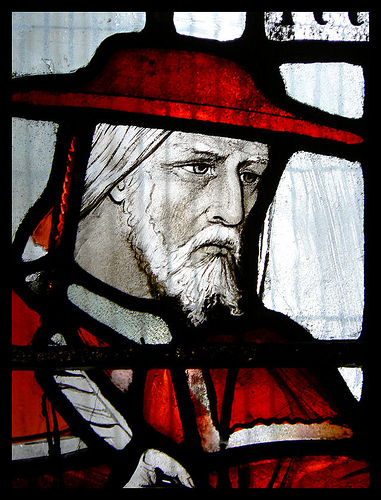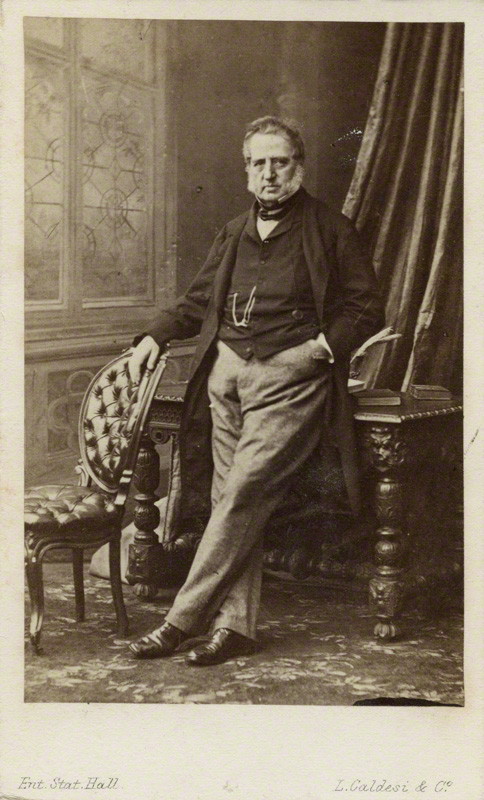|
Frederick Erasmus Edwards
Frederick Erasmus Edwards FGS (1 October 1799 – 15 October 1875) was a British law clerk in the Court of Chancery and an amateur geologist, known for his collection of Eocene Tertiary Mollusca. F. E. Edwards, with James Scott Bowerbank and five other naturalists, founded the London Clay Club in 1836 and was also a founding member of the Palaeontographical Society in 1847. For more than forty years he was a law clerk in the Court of Chancery, working as chief clerk for two Masters of the Rolls, Wingfield and Blunt, and two Vice-Chancellors, Sir Richard Torin Kindersley and Sir Richard Malins Sir Richard Malins (9 March 1805 – 15 January 1882) was an English barrister, judge, and politician. Early life The third son of William Malins of Ailston, Warwickshire, by his wife Mary, eldest daughter of Thomas Hunter of Pershore, Worceste .... Edwards devoted his leisure time to the collection and study of fossil Mollusca. References 1799 births 1875 deaths Amateur geol ... [...More Info...] [...Related Items...] OR: [Wikipedia] [Google] [Baidu] |
Geological Society Of London
The Geological Society of London, known commonly as the Geological Society, is a learned society based in the United Kingdom. It is the oldest national geological society in the world and the largest in Europe with more than 12,000 Fellows. Fellows are entitled to the postnominal FGS (Fellow of the Geological Society), over 2,000 of whom are Chartered Geologists (CGeol). The Society is a Registered Charity, No. 210161. It is also a member of the Science Council, and is licensed to award Chartered Scientist to qualifying members. The mission of the society is: "Making geologists acquainted with each other, stimulating their zeal, inducing them to adopt one nomenclature, facilitating the communication of new facts and ascertaining what is known in their science and what remains to be discovered". History The Society was founded on 13 November 1807 at the Freemasons' Tavern, Great Queen Street, in the Covent Garden district of London. It was partly the outcome of a previous cl ... [...More Info...] [...Related Items...] OR: [Wikipedia] [Google] [Baidu] |
Court Of Chancery
The Court of Chancery was a court of equity in England and Wales that followed a set of loose rules to avoid a slow pace of change and possible harshness (or "inequity") of the Common law#History, common law. The Chancery had jurisdiction over all matters of equity, including English trusts law, trusts, English property law, land law, the estates of Mental illness, lunatics and the guardianship of infants. Its initial role was somewhat different: as an extension of the lord chancellor's role as Keeper of the King's Conscience, the court was an administrative body primarily concerned with conscientious law. Thus the Court of Chancery had a far greater remit than the common law courts, whose decisions it had the jurisdiction to overrule for much of its existence, and was far more flexible. Until the 19th century, the Court of Chancery could apply a far wider range of remedies than common law courts, such as specific performance and injunctions, and had some power to grant damage ... [...More Info...] [...Related Items...] OR: [Wikipedia] [Google] [Baidu] |
James Scott Bowerbank
James Scott Bowerbank (14 July 1797 – 8 March 1877) was a British naturalist and palaeontologist. Biography Bowerbank was born in Bishopsgate, London, and succeeded in conjunction with his brother to his father's distillery, in which he was actively engaged until 1847. In early years astronomy and natural history, especially botany, engaged much of his attention; he became an enthusiastic worker at the microscope, studying the structure of shells, corals, moss agates, and flints. He also formed an extensive collection of fossils. The organic remains of the London Clay attracted particular attention, and about the year 1836 he and six other workers founded The London Clay Club – the members comprising Dr Bowerbank, Frederick E. Edwards (1799–1875), author of ''The Eocene Mollusca'' ( Palaeontograph. Soc.), Searles Valentine Wood, John Morris, Alfred White (zoologist), N. T. Wetherell, surgeon of Highgate (1800–1875), and James De Carle Sowerby. In 1840, Bowerbank pu ... [...More Info...] [...Related Items...] OR: [Wikipedia] [Google] [Baidu] |
Palaeontographical Society
The Palaeontographical Society is a learned society, established in 1847, and is the oldest extant Society devoted to the advancement of palaeontological knowledge. The Society publishes monographs that further its primary purpose, which is to promote the description and illustration of fossil floras and faunas from Great Britain and Ireland. Since starting publishing in March 1848 (Searles Valentine Wood's work ) the Society has published over 600 monographs. History The precursor of the Paleontographical Society was The London Clay Club, which was founded in 1836 by James Scott Bowerbank and six other naturalists; the Club was superseded in 1847 by the Palaeontographical Society. The first council of the Society was presided over by Sir Henry Thomas de la Beche. Initial membership included: Prof. Thomas Bell, Frederick E. Edwards, Sir Philip de Malpas Grey Egerton, Hugh Falconer, William H. Fitton, J.W. Flower, Prof. Edward Forbes, Levett Landon Boscawen Ibbetson, Charles Lyell ... [...More Info...] [...Related Items...] OR: [Wikipedia] [Google] [Baidu] |
Master Of The Rolls
The Keeper or Master of the Rolls and Records of the Chancery of England, known as the Master of the Rolls, is the President of the Court of Appeal (England and Wales)#Civil Division, Civil Division of the Court of Appeal of England and Wales and Head of Civil Justice. As a judge, the Master of the Rolls is second in seniority in England and Wales only to the Lord Chief Justice of England and Wales, Lord Chief Justice. The position dates from at least 1286, although it is believed that the office probably existed earlier than that. The Master of the Rolls was initially a clerk responsible for keeping the "Rolls" or records of the Court of Chancery, and was known as the Keeper of the Rolls of Chancery. The Keeper was the most senior of the dozen Chancery clerks, and as such occasionally acted as keeper of the Great Seal of the Realm. The post evolved into a judicial one as the Court of Chancery did; the first reference to judicial duties dates from 1520. With the Supreme Court of ... [...More Info...] [...Related Items...] OR: [Wikipedia] [Google] [Baidu] |
Chancellor Of The High Court
The Chancellor of the High Court is the head of the Chancery Division of the High Court of Justice of England and Wales. This judge and the other two heads of divisions (Family and Queens Bench) sit by virtue of their offices often, as and when their expertise is deemed relevant, in panel in the Court of Appeal. As such this judge ranks equally to the President of the Family Division and the President of the Queen's Bench Division. From 1813 to 1841, the solitary and from 1841 to 1875, the three puisne judge, ordinary judges of the Court of Chancery — rarely a court of first instance until 1855 – were called vice-chancellors. The more senior judges of the same court were the Lord Chancellor and the Master of the Rolls (who were moved fully to the Court of Appeal above in 1881). Each would occasionally hear cases alone or make declarations on paper applications alone. Partly due to the old system of many pre-pleadings, pleadings and hearings before most cases would reach Cha ... [...More Info...] [...Related Items...] OR: [Wikipedia] [Google] [Baidu] |
Richard Torin Kindersley
Sir Richard Torin Kindersley (1792–1879) was an English lawyer and judge. He was born, the eldest son of Nathaniel Edward Kindersley, at Madras, India, in 1792, and educated at Haileybury and Trinity College, Cambridge, becoming a fellow in 1815 and M.A. in 1817. He was called to the Bar ( Lincoln's Inn) in 1818 and developed a Chancery practice. From 1847 to 1851, he served as Chancellor of the County Palatine of Durham. In 1848 he was appointed Master in Chancery, followed by an appointment as Vice-Chancellor in 1851. He had a reputation as a sound equity judge. He retired in 1866, but continued to sit on the Judicial Committee of the Privy Council. References Fellows of Trinity College, Cambridge 19th-century English judges Members of the Judicial Committee of the Privy Council 1792 births 1879 deaths Members of the Privy Council of the United Kingdom Richard Richard is a male given name. It originates, via Old French, from Old Frankish and is a ... [...More Info...] [...Related Items...] OR: [Wikipedia] [Google] [Baidu] |
Richard Malins
Sir Richard Malins (9 March 1805 – 15 January 1882) was an English barrister, judge, and politician. Early life The third son of William Malins of Ailston, Warwickshire, by his wife Mary, eldest daughter of Thomas Hunter of Pershore, Worcestershire, and was born at Evesham on 9 March 1805. He was educated at a private school, and then entered Caius College, Cambridge in 1823, where he graduated B.A. in 1827. He had already joined the Inner Temple in 1825, and was called to the bar 14 May 1830. Malins practised as an equity draughtsman and conveyancer in Fig Tree Court, Temple, and later in New Square and in Stone Buildings, Lincoln's Inn. He made his way professionally without backing, interest, concentrated on real property law and the interpretation of wills, and built up a court practice in equity. He trained in his chambers numerous pupils, including Hugh Cairns who was his assistant for some time. In 1849 Malins transferred his membership from the Inner Temple to Li ... [...More Info...] [...Related Items...] OR: [Wikipedia] [Google] [Baidu] |
British Museum
The British Museum is a public museum dedicated to human history, art and culture located in the Bloomsbury area of London. Its permanent collection of eight million works is among the largest and most comprehensive in existence. It documents the story of human culture from its beginnings to the present.Among the national museums in London, sculpture and decorative and applied art are in the Victoria and Albert Museum; the British Museum houses earlier art, non-Western art, prints and drawings. The National Gallery holds the national collection of Western European art to about 1900, while art of the 20th century on is at Tate Modern. Tate Britain holds British Art from 1500 onwards. Books, manuscripts and many works on paper are in the British Library. There are significant overlaps between the coverage of the various collections. The British Museum was the first public national museum to cover all fields of knowledge. The museum was established in 1753, largely b ... [...More Info...] [...Related Items...] OR: [Wikipedia] [Google] [Baidu] |
1799 Births
Events January–June * January 9 – British Prime Minister William Pitt the Younger introduces an income tax of two shillings to the pound, to raise funds for Great Britain's war effort in the French Revolutionary Wars. * January 17 – Maltese patriot Dun Mikiel Xerri, along with a number of other patriots, is executed. * January 21 – The Parthenopean Republic is established in Naples by French General Jean Étienne Championnet; King Ferdinand I of the Two Sicilies flees. * February 9 – Quasi-War: In the single-ship action of USS ''Constellation'' vs ''L'Insurgente'' in the Caribbean, the American ship is the victor. * February 28 – French Revolutionary Wars: Action of 28 February 1799 – British Royal Navy frigate HMS ''Sybille'' defeats the French frigate ''Forte'', off the mouth of the Hooghly River in the Bay of Bengal, but both captains are killed. * March 1 – Federalist James Ross becomes President pro tempore of the United States Senate. * ... [...More Info...] [...Related Items...] OR: [Wikipedia] [Google] [Baidu] |
1875 Deaths
Events January–March * January 1 – The Midland Railway of England abolishes the Second Class passenger category, leaving First Class and Third Class. Other British railway companies follow Midland's lead during the rest of the year (Third Class is renamed Second Class in 1956). * January 5 – The Palais Garnier, one of the most famous opera houses in the world, is inaugurated in Paris. * January 12 – Guangxu becomes the 11th Qing Dynasty Emperor of China at the age of 3, in succession to his cousin. * January 14 – The newly proclaimed King Alfonso XII of Spain (Queen Isabella II's son) arrives in Spain to restore the monarchy during the Third Carlist War. * February 3 – Third Carlist War – Battle of Lácar: Carlist commander Torcuato Mendíri secures a brilliant victory, when he surprises and routs a Government force under General Enrique Bargés at Lácar, east of Estella, nearly capturing newly crowned King Alfonso XII. The C ... [...More Info...] [...Related Items...] OR: [Wikipedia] [Google] [Baidu] |
Amateur Geologists
An amateur () is generally considered a person who pursues an avocation independent from their source of income. Amateurs and their pursuits are also described as popular, informal, self-taught, user-generated, DIY, and hobbyist. History Historically, the amateur was considered to be the ideal balance between pure intent, open mind, and the interest or passion for a subject. That ideology spanned many different fields of interest. It may have its roots in the ancient Greek philosophy of amateur athletes competing in the Olympics. The ancient Greek citizens spent most of their time in other pursuits, but competed according to their natural talents and abilities. The "gentleman amateur" was a phenomenon among the gentry of Great Britain from the 17th century until the 20th century. With the start of the Age of Reason, with people thinking more about how the world works around them, (see science in the Age of Enlightenment), things like the cabinets of curiosities, and the wri ... [...More Info...] [...Related Items...] OR: [Wikipedia] [Google] [Baidu] |








